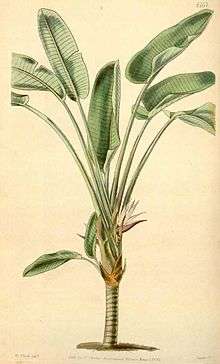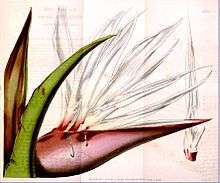Strelitzia alba
| Strelitzia alba | |
|---|---|
 | |
| Plate 4167 by Walter Hood Fitch for Curtis's Botanical Magazine vol 71 (1845) | |
| Scientific classification | |
| Kingdom: | Plantae |
| (unranked): | Angiosperms |
| (unranked): | Monocots |
| Order: | Zingiberales |
| Family: | Strelitziaceae |
| Genus: | Strelitzia |
| Binomial name | |
| Strelitzia alba (L.f.) Skeels | |
| Synonyms[1] | |
| |

Strelitzia alba is a tree of the Bird of Paradise family and is endemic to the Garden Route along the southernmost coastal regions of the Eastern and Western Cape in South Africa. The Swedish botanist Thunberg, who in 1792 described and published it in Nov. Gen. Pl.: 113 as Strelitzia augusta, first found it in the neighbourhood of the Piesang River at Plettenberg Bay - 'piesang' being Afrikaans for 'banana'. Francis Masson, who was then the Botanical Collector for Kew, introduced it to Europe in 1791. [2] This is one of three arborescent Strelitzias, the other two being Strelitzia caudata and Strelitzia nicolai.
Description
This frost-sensitive, clump-forming perennial can grow to 10m tall, with leaves measuring 2m by 0.6m. The leaves are often tattered by strong winds or hail. As the specific name suggests, the flowers are completely white and lack the blue colour found in other species. Flowering may take place at any time of the year, but is usually between July and December. The 30cm long boat-shaped bract encloses from five to ten flowers which emerge in sequence. The fruit is a woody capsule, splitting into three lobes to reveal black seeds with a yellow/orange tufty aril. The clean trunk bears the scars of old leaf-bases.
References
| Wikimedia Commons has media related to Strelitzia alba. |
- ↑ "World Checklist of Selected Plant Families".
- ↑ Curtis's Botanical Magazine